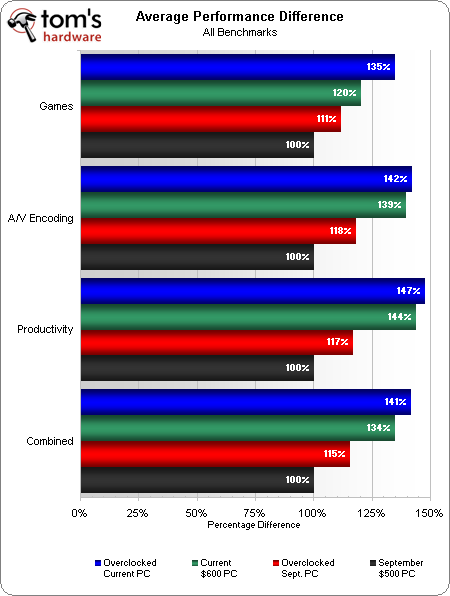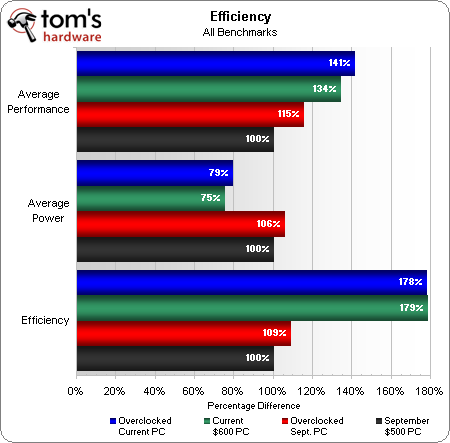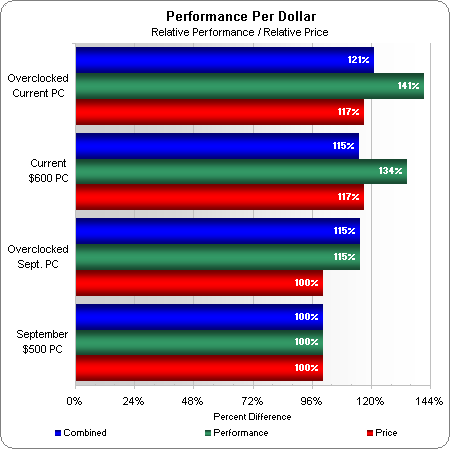System Builder Marathon, Dec. 2011: $600 Gaming PC
Can Core i5-2400 Justify Its Higher Cost?
We’ll summarize performance and efficiency using September’s stock $500 system as a base.
Performance Summary
Upgrading to a Core i5-2400 paid off with a clean sweep in performance. That’s right: the current PC won in every single gaming, encoding, and productivity test from our System Builder Marathon suite.
Efficiency
Of course, the current PC dominates in efficiency by delivering greater performance throughout the entire test suite as it draws far less power at both idle and load.
Value
We would hope that the extra money spent on a higher-end CPU would justify itself with performance to match. However, an extra $70 expense is significant enough to warrant a comparison based on bang for the buck. We’ll handicap the current rig by using overall system cost, meaning that, in order to win, the December PC needs to make up for mark-ups on the hard drive and video card, as well as the additional cost of a more feature-rich motherboard.
Based on average performance, our best overclocking efforts back in September are only able to match the value of this quarter's $600 machine at its stock settings. Once we factor in the added performance attributable to overclocking its graphics card and lower memory latency, the current PC has a clear value lead.
Conclusion
Intel's Core-i5 2400 really is that good. Despite our H61 motherboard pairing, which completely neuters overclocking, the December $600 Gaming PC is able to address the major compromises we were forced to make with the past two $500 machines. Beating the prior system in every single performance test, offering outstanding efficiency, and even delivering more overall value at a higher cost is a pretty impressive list of accomplishments we credit to the pricier processor.
Conversely, the December rig isn't the right choice for everyone. After all, it costs quite a bit more than our previous effort. When it comes to cranking up the eye candy at the highest quality settings, a single mid-range graphics card is the biggest performance inhibitor, not the CPU. For many folks, the best native 1920x1080 gaming experience may be all that matters. Stepping down to a more affordable Sandy Bridge-based Pentium or Core i3-2100 would facilitate a GeForce GTX 560 Ti or Radeon HD 6950 at the same budget level. And once we step back down to sub-$125 processors, the AMD FX-4100 and older Athlon/Phenom II offerings are also viable options.
Current page: Can Core i5-2400 Justify Its Higher Cost?
Prev Page Power Consumption And TemperaturesGet Tom's Hardware's best news and in-depth reviews, straight to your inbox.
-
Probably the best bang for buck build compared to the $2400 and $1200 PC. I remember seeing Anandtech using the A8 series with integrated gpu for their $500/600 build. This looks much better for gaming.Reply
-
compton The 2500K is really worth the extra cash over the 2400, but only if you purchase a Z68 or P67. For gaming, you might be better off with an i3 and putting the remainder towards a faster GPU as suggested in the conclusion.Reply
For the price, the 2500K + a P67 or Z68 is unbeatable and certainly worth breaking the budget over. But for SBM, I can see why going the 2400 plus H61 route makes sense.
Personally, I would have preferred to see a cheaper motherboard and CPU config with an SSD (instead of the mechanical storage). It wouldn't have scored as well, but I can't get by without an SSD as easily as I could a slower processor.
I wanted the $500 build to get bumped up to $600, but that was to add a SSD so that each SBM machine could have some solid state action.
-
slicedtoad i might be missing something but on the just cause 2 chart:Reply
Enabling 8xAA at the highest detail levels pushes our graphics hardware, and this quarter's machine is unable to beat the former rig running at 3.8 GHz, even at our lowest resolution.
The chart seems to indicate that the current machine did beat the former... though perhaps not by alot. -
slicedtoad ReplyStepping down to a more affordable Sandy Bridge-based Pentium or Core i3-2100 would facilitate a GeForce GTX 560 Ti or Radeon HD 6950 at the same budget level.
So would a 6950 + i3 give better performance in games @ 1080x1920 than this build? -
lancelot123 I must be lucky that I can get 2500K for $180 around here. Cheaper than the 2400 they have in this.Reply -
doron Replyin order to win, the December PC needs to make up for mark-ups on the hard drive and video card, as well as the additional cost of a more feature-rich motherboard.
Definitely a kick-ass machine, but imo this line is simply wrong and misleading.
If you factor out today's and September's cpu and motherboard, the difference between the rest of the parts is a mere 8$. Furthermore, with only 2 dimms and no overclocking capability whatsoever I really can't see how you can call this MSI board a more "feature-rich" than September's ASRock.
The way I see it, today's and September's machines are in two different price segments, and at this low budget, pouring an extra ~90$ can actually give you a lot. For example, given today's system, if we take out the cpu, motherboard and gpu, we will be able to fit inside a Phenom II x4 960T (125$), some 60$-70$ motheboard, an hd6950 1gb gpu, and probably still have room for a 20$ HSF. Talk about value.
I'm not trying to defend amd here or anything, It's just that a lot of times people come to me asking for advice on what computer to get, and I can fairly confidently say that when someone wants a 4 core sandy bridge at this budget, I'll say to him that I won't help and tell him to go find a deal somewhere because in my eyes, getting a cpu that's 1/3 of your budget only to be able to get an extra minute or two in every benchmark or getting high fps in low resolutions, is too much of a compromise in every other component.



